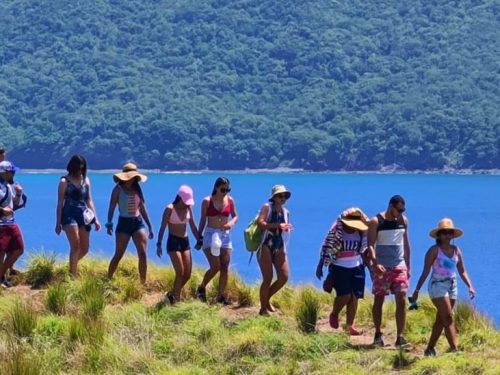
Expansion work on the Barranca – Limonal route won’t end until 2026, three years later than originally planned. That’s what the vice minister of infrastructure, Efraim Zeledón, told The Voice of Guanacaste.
The project began in February of 2020 and the H.Solís – Estrella consortium was in charge of it until October of 2022, when they requested to terminate the contract with the Ministry of Public Works and Transportation (MOPT). The construction companies only made 18% progress on the work, according to information provided by MOPT’s press office.
The Voice emailed Ingeniería Estrella and H.Solís to find out the reasons they abandoned the work, but neither of them responded. In July of 2022, then Vice Minister of Infrastructure Alejandro Guillén attributed H. Solís’ involvement in the Cochinilla case as one of the motives for why the work came to a standstill.
Barranca – Limonal is part of the North Inter-American Highway, the main route to get to Guanacaste, which also connects the country with the rest of Central America. The unfinished work causes traffic jams and makes drivers have to dodge obstacles and ditches that put their lives at risk.
Indispensable Road for Transportation and Tourism
Nineteen percent of the country’s exports are destined for a Central American country, not including Panama, according to data from the Foreign Trade Promoter (Spanish acronym: PROCOMER).
To the executive vice president of the National Chamber of Cargo Carriers (Spanish acronym: CANATRAC), Francisco Quirós, this data provides a measurement of the importance of the Inter-American Highway being in good condition.
According to Quirós’s calculations, the lack of movement on the project has caused travel times to increase between 15% and 20%. “This inefficiency translates, more than anything, into delivery times and, of course, higher fuel consumption.”
One of those affected is Wilberth Vázquez. The delivery driver has worked for a parcel company for 14 years and travels that route twice a day. “Before this project started, it was easier to travel through,” he commented.
If I make a bad maneuver, I’d fall into one of those ditches that are there. God willing, that doesn’t happen, because there’d be nothing left. And if I pull the other way, I can take out the car that’s coming the opposite way,” he commented.
According to Vázquez, there are days that it takes him up to two more hours doing his routes due to the poor condition of the highway. “A delay like that means less time that I’m sleeping with my wife and spending time with my kids,” he commented.
The halted work doesn’t just affect the transportation industry. The president of the Guanacaste Chamber of Tourism (Spanish acronym: CATURGUA), Hernán Binaghi, thinks that the highway’s bad condition makes tourists unwilling to travel to Guanacaste.
“Nowadays, people get on the Barranca – Limonal section and they never know how long it’s going to take. So when you want to plan, now you say ‘no, we better not go there,’ because it really is very tiring,” remarked Binaghi.
Project Will Be More Expensive
MOPT will open a new bidding process to award the work to another company, which will take “a good part of 2024,” Zeledón said.
The amount for which the completion of the work will be awarded will be $175 million, coming from a loan from the Central American Bank for Economic Integration (CABEI).
CABEI’s chief officer for the country in Costa Rica, Álvaro Alfaro, explained that this month, he will submit the approval of a new loan of approximately $400 million to the 15 directors of the bank’s other branches. The money will be earmarked for MOPT projects, including the expansion of Barranca – Limonal, of Radial Lindora, the Hatillo 7 overpass and road improvements to several national highways.
Initially, the work had gotten underway with another loan also, of $182 million, but from the Inter-American Development Bank (IDB). MOPT only disbursed $34 million to the consortium.
According to Zeledón, the money that was left over is not enough to finish the route. “Prices have gone up,” he explained.
What will happen to the remaining money from the IDB loan? According to the vice minister, MOPT still owes money to the consortium for the work carried out on Barranca – Limonal. In addition, $100 million of the amount will be invested in the San Carlos route.
MOPT: Work Can’t Withstand Another Rainy Season
The progress of only 18% on the Barranca – Limonal work is at risk due to lack of maintenance. According to Vice Minister Zeledón, the grass that grows on the asphalt damages the ballast placed by H.Solis – Estrella. In addition, the rain threatens the iron beams that were left on the road.
There, $30 million [$34 million, the press office specified] has already been invested in works that we are going to lose if we simply leave them there abandoned,” said the vice minister.
To avoid the work deteriorating, MOPT will once again resort to a loan from IDB to make “emergency contracts” and take care of the route. The approximate amount of the credit is $20 million.
The vice minister of infrastructure said that maintenance work will begin in October. The Voice sent inquiries to IDB by mail (as indicated by the bank’s press department) to verify the amount of the loan and the possible approval date. The press office responded that they cannot address the issue because they are currently in negotiations with the government.







Comments